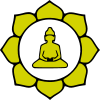Ango
For the river in Siberia, see Ango river. For the medieval weapon, see Angon. For the lunar crater, see Mons Vinogradov.
| Part of a series on |
| Zen Buddhism |
|---|
 |
|
Persons Chán in China
Zen in Japan Seon in Korea Zen in the USA Category: Zen Buddhists |
|
Awakening |
|
Practice |
|
Related schools |
| Part of a series on |
| Mahāyāna Buddhism |
|---|
 |
|
Teachings |
|
Mahāyāna schools |
|
|
An ango (安居), or kessei (結制), is a Japanese term for a three-month period of intense training for students of Zen Buddhism, lasting anywhere from 90 to 100 days.[1] The practice during ango consists of meditation (zazen), study, and work (samu(作務)).
Ango is typically held twice a year, the first period from spring to summer and the second period from fall to winter.[2] The word ango literally translates as "dwelling in peace"; the summer ango is referred to as ge-ango and the winter period is u-ango.[3] Additionally, some monasteries and Zen centers hold just one ango per year.[4]
[5] Concerning Zen practice in the United States, author Ellen Birx writes,
Many centers now allow members to attend retreats on a part-time basis. Many have ango, a three-month-long period of intensified practice, that members can participate in while continuing to go off to work during the day."[6] Taigen Dan Leighton writes a more traditional definition, "These are ninety-day training periods of concentrated practice without leaving the monastic enclosure (except for monks going out for necessary temple business). They date back to the summer rainy season retreats of Shakyamuni's time. In Japan, they have been held twice a year, summer and winter."[7]
See also
Notes
References
- Birx, Ellen (2005). Waking Up Together: Intimate Partnership on the Spiritual Path. Wisdom Publications. ISBN 0-86171-395-8.
- Fischer-Schreiber, Ingrid; Schuhmacher, Stephan; Woerner, Gert (1994). The Encyclopedia of Eastern Philosophy and Religion: Buddhism, Taoism, Zen, Hinduism. Shambhala Publications. ISBN 0-87773-980-3.
- Ford, James Ishmael (2006). Zen Master Who?: A Guide to the People and Stories of Zen. Wisdom Publications. ISBN 0-86171-509-8.
- Hakeda, Yoshito S.; Bankei; Haskel, Peter (1994). Bankei Zen: Translations from the Record of Bankei. Grove Press. ISBN 0-8021-3184-0.
- Leighton, Taigen Dan; Okumura, Shohaku; Dogen (1996). Dogen's Pure Standards for the Zen Community a Translation of the Eihei Shingi. State University of New York Press. ISBN 0-585-04623-9.
- Maezumi, Taizan; Glassman, Bernard (2002). On Zen Practice: Body, Breath, Mind. Wisdom Publications. ISBN 0-86171-315-X.
- Prebish, Charles S (1999). Luminous Passage: The Practice and Study of Buddhism in America. University of California Press. ISBN 0-520-21697-0.
This article is issued from Wikipedia - version of the 7/3/2016. The text is available under the Creative Commons Attribution/Share Alike but additional terms may apply for the media files.